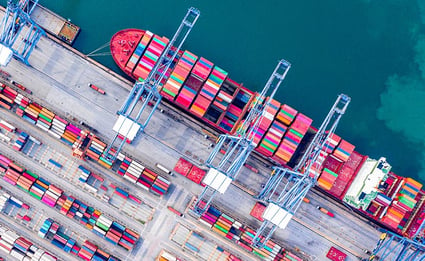A Super Simple Supply Chain Model
Keith LaBotz - September 23, 2021

Transportation is the key to unlocking supply chain visibility, but there’s one catch. The key only works with a super simple supply chain model. The supply model you will learn about is so small and simple, it’s easy to overlook. Some might even dismiss it as too easy. That’s its beauty.
Models
Let’s talk about models. You probably already know a model is a physical analog (analogy) that helps us understand abstract ideas like supply chains. In my last post, Five Things They Didn’t Tell You About Visibility, I mentioned the TV series Kung Fu is a favorite because it presents contrasting perspectives. A model can do the same thing, allowing us to see things that would otherwise hide in plain sight.
One more thing about models. They are interpretations - one person’s understanding, and as such, they come and go as we learn more. We trade up, revise, and discard them as we see fit. They’re tools that only have value if they can help us.
The model I’m going to share with you is just my opinion, and I welcome any comments or criticisms that will improve it. I submit my model to you for your feedback as well as for your benefit.
Your Current Supply Chain Model
You may already have a supply chain model, and you’ll decide whether to keep it or adopt my super simple model instead. Your supply chain model is the image you visualize when trying to understand or explain the supply chain. Hang onto that and after you’ve finished reading this post, go with the model that works best for you.
The Historical Supply Chain Model
Is there a historical precedent to validate our super simple model? Yes, there is, and that’s a good sign it's on the right track. A good model is technology agnostic, and it should comport with the past, present, and future understanding of supply chains. Our super simple model does that.
The earliest supply chains were caravans and boats that worked the ancient trade routes. Trade and transportation were synonymous, and of course, processes were far more straightforward. Infrastructure has always advanced with technology to improve the transportation of goods (trade). Internal combustion engines, microchips, and even the term “supply chain” entered the picture very recently in history.
Supply Chain Identity Crisis
We sit at the end of several thousand years of supply chain evolution and see layers of infrastructure and technology built up around the supply chain. Our interface is with the systems that manage the systems managing transportation. Transportation remains at the core of the supply chain, but now it’s obscured by technology.
The buzz about this shiny new technology leads us to believe technology delivers the goods instead of trains, planes, trucks, ships, and pipelines. When did a Transportation Planning and Scheduling solution last leave a package on your front porch? Supply chain technology delivers nothing - it facilitates transportation. Our perspective of the supply chain is losing touch with logistics realities. Many logistics professionals manage transportation as a series of functions, KPIs, and goals, having never spent time on a warehouse floor. While visibility platforms promise to restore realism by providing a more holistic view, it also adds another system to compound the problem.
The problem of a crowded information ecosystem is the difficulty of contending with multiple technology layers. Accessing data and initiating changes in execution that maintain synchronicity can be a very risky proposition. Supply chain visibility is situational awareness, and it requires an accurate assessment of change in real-time. More systems add more risk and cost. Hey, do I sound like an ERP salesperson?
Supply chain visibility requires clear, direct access to transportation data and functions. Providing that has a lot to do with the supply chain model your enterprise is using. If transportation is at the core of a supply chain model, process improvements will align to support it, resulting in easier access and control of logistics execution.
A Super Simple Supply Chain Model
Here’s a description of a super simple supply chain model.
-
Picture a chain where each loop represents a supply chain partner.
-
The chain provides the history of a single SKU (order) as it moves to the next trading partner towards the final consumer.
-
Each loop represents a partner with custody of the SKU, and they connect in the sequence material was transferred from one partner to the next.
-
The final customer is the last link on the chain.
-
Transportation is the physical link between trading partners
-
Nothing moves in a supply chain without transportation.
-
Transportation is the link in a supply chain.
-
Transportation consists of a shipping and a receiving transaction; each link in a supply chain consists of at least one shipping and receiving transaction.
-
The supply chain consists of links; a supply chain consists of transportation.
-
The supply chain is transportation.
The Supply Chain is Transportation
Think of the supply chain as transportation, and all other functions exist to support transportation. Stakeholder expectations drive transportation, which includes customer requirements, sustainability goals, business objectives, and other requirements.
Q: What about all the other activities in a supply chain like procurement, planning, logistics, operations, sales, and services?
A: These activities, the entire supply chain, and your enterprise processes exist to support transportation. In the super simple model, transportation is the core of the supply chain. Here are a few implications of our transportation-centric supply chain.
- Instead of treating transportation as a function that serves other supply chain processes, flip that view, so all other supply chain processes serve transportation.
- Supply chain processes exist to account for material, data, and funds as the material is transferred between partners, facilities, trailers, and shipping containers.
- Companies in the chain are merely staging points in a more extensive transportation process.
- Shipment tracking should share a data model with other enterprise processes that nests containers of SKUs identified with orders, serial numbers, and manufacturing lots. This allows technologies like IoT with 5G to intercept freight and supports more challenging change scenarios.
- Stakeholder requirements should drive all processes and supply chain visibility.
- Material and data flow together in a universal transportation process, irrespective of shipping mode, order types, trading partners, and business systems.
Putting Your Super Simple Model to Work
What I like about the model is that it maps the movement of freight in the supply chain. That’s a very useful tool for systems integration when implementing visibility. You can walk through and follow a shipment through your enterprise and partner processes and see how and where to capture data. You can also identify integration points and the optimal points for physically intercepting freight. These features make crucial for meeting two requirements for effective visibility:
- Monitoring execution level details and determines the optimal response and;
- Controlling execution level processes for the optimal outcome.
You will find it easiest to increase visibility by targeting basic transportation transactions such as load tendering, delivery, shipping, and receiving. These are universal transactions found in all operations, mature and stable, and modeled around ANSI EDI going back 50 years, so they are a great starting point.
Conclusion
My intention is to get you to think differently about the supply chain and your solution for visibility. If my model was able to do that, then it served both of us.
If you spend more time thinking about this model, I believe you’ll find it’s a gamechanger for supply chain optimization. That may be more evident after you’ve defined visibility for your company and vision of your future, high-visibility supply chain. If you align your vision with my super simple model, you will find it much easier to achieve your goals and onboard transportation and 3PL partners to make it happen.
Keep in mind the super simple model is merely my opinion, and the model could be flawed. Convince yourself of its correctness and utility and if you find a problem with it, let me know so I can get back to you with a better model.
If you want to learn more get your Guide to Logistics 4.0
In this Guide you will learn:
-
Why a strategic process in transportation planning is a top priority for digitalization
-
What megatrends will increase supply chain volatility
-
How to manage it
LATEST POSTS
- Understand Why Production Planning Needs Specialized Solutions
- Understand Circular Economy in The Manufacturing Industry
- How Can Industry 4.0 IT Integration Be Achieved Smoothly?
- The Significance of Order Sequencing in Discrete Manufacturing
- How to improve your Supply Chain Management: The Power of Control Towers



